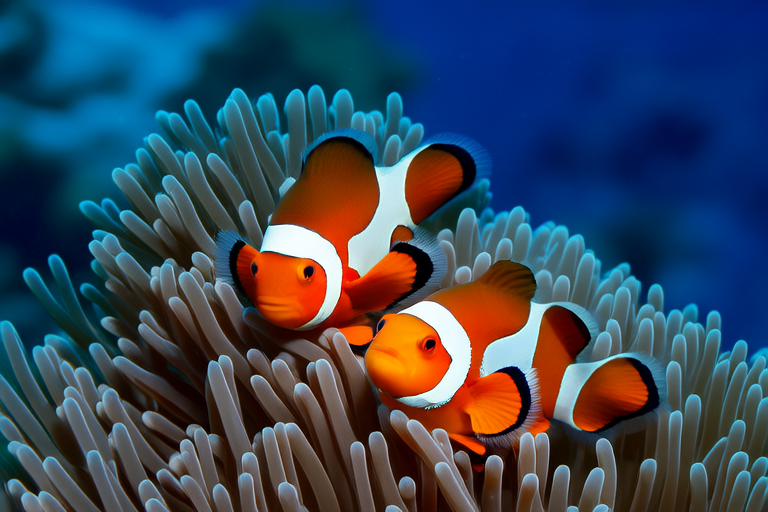Clownfish Companionship: Best Tank Mates and Tips
Introduction: Clownfish, also known as anemonefish, are popular choices for many saltwater aquariums due to their vibrant colors and engaging behaviors. These fish have unique relationships with sea anemones, which provide them with protection from predators and a place to lay eggs. Understanding clownfish behaviors and their compatibility needs is crucial for creating a harmonious reef aquarium. This article explores the best tank mates for clownfish, the importance of selecting compatible species, and provides tips for setting up a healthy, thriving environment.
Understanding Clownfish Behaviors and Compatibility Needs
Clownfish are social creatures that thrive in groups within their natural habitat. In captivity, they tend to be territorial but can coexist peacefully with other species if certain conditions are met. They prefer environments rich in live rock and coral, offering ample hiding spots and areas for exploration. The key to successful clownfish companionship lies in selecting tank mates that share similar environmental requirements and temperaments.
The Importance of Selecting Appropriate Tank Mates
Selecting appropriate tank mates is essential for maintaining a peaceful and healthy aquarium. Compatible species should have similar water chemistry preferences, temperature requirements, and behavioral tendencies. It’s important to avoid aggressive or overly competitive species that might bully or stress out the clownfish. Additionally, tank mates should be able to coexist without competing for resources like food or space.
Recommended Tank Mates for Clownfish
- Blue Gobies: Blue gobies are excellent tank mates for clownfish because they are generally peaceful and shy. They prefer to stay near the bottom of the tank, leaving the mid-water level for clownfish to explore. Their docile nature makes them less likely to compete with clownfish for food or territory.
- Synchiropus splendidus (Firefish): Firefish are small, colorful fish that add visual appeal to the tank. They are typically non-aggressive and can coexist well with clownfish. However, it’s important to monitor their interactions, as firefish may become stressed if clownfish are too aggressive.
- Pseudochromis fuscater (Dottybacks): Dottybacks are small, active fish that can be great additions to a clownfish tank. They are territorial but usually do not pose a threat to clownfish. Providing plenty of hiding spots helps reduce potential conflicts.
- Yellow Tangs: Yellow tangs are herbivores that graze on algae, helping to keep the tank clean. They are generally peaceful and can coexist with clownfish. However, they require ample swimming space and a varied diet to thrive.
- Blennies: Blennies are small, bottom-dwelling fish that are often curious and playful. They can be great tank mates for clownfish as long as there is enough space for both species to explore without conflict.
Tips for Setting Up a Healthy, Thriving Environment
To ensure a healthy and thriving environment for your clownfish and their tank mates, follow these guidelines:
Ideal Tank Size
A minimum tank size of 30 gallons is recommended for a single pair of clownfish. Larger tanks allow for more space and better water quality, reducing stress and promoting healthier fish. For every additional fish, add approximately 10 gallons to accommodate their needs.
Water Conditions
Maintaining optimal water conditions is crucial for the health of your clownfish and their tank mates. Aim for a temperature range of 76-82°F (24-28°C) and a pH level between 8.1 and 8.4. Regular testing and maintenance of water parameters help prevent issues like ammonia spikes or pH fluctuations.
Hiding Spots
Providing ample hiding spots is essential for clownfish and their tank mates. Live rock and coral offer natural hiding places, while artificial caves and tunnels can also be beneficial. Ensure that there are enough hiding spots for all fish to feel secure and reduce territorial disputes.
Maintaining a Balanced Ecosystem
Creating a balanced ecosystem requires ongoing attention and care. Regular water changes, proper filtration, and a varied diet contribute to the overall health of your aquarium. Monitor the behavior of your fish regularly to catch any signs of stress or aggression early. Addressing issues promptly helps maintain harmony among all inhabitants.
In conclusion, selecting the right tank mates and setting up a healthy environment are vital steps in ensuring the longevity and well-being of your clownfish and their companions. By following these guidelines, you can create a vibrant and thriving reef aquarium that brings joy and fascination to all who observe it.
